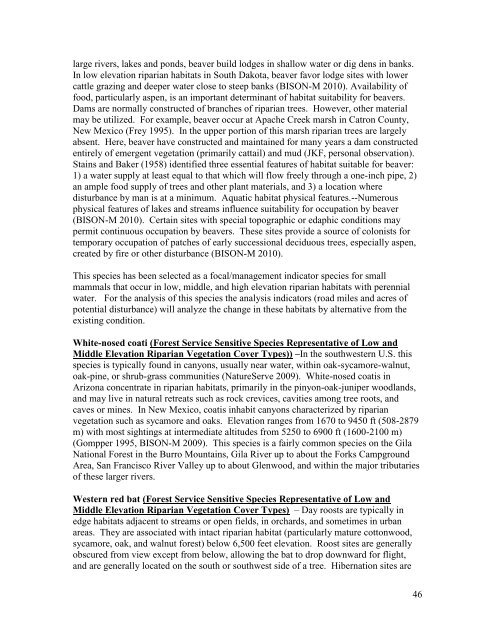Wildlife Specialist report
Wildlife Specialist report
Wildlife Specialist report
You also want an ePaper? Increase the reach of your titles
YUMPU automatically turns print PDFs into web optimized ePapers that Google loves.
large rivers, lakes and ponds, beaver build lodges in shallow water or dig dens in banks.<br />
In low elevation riparian habitats in South Dakota, beaver favor lodge sites with lower<br />
cattle grazing and deeper water close to steep banks (BISON-M 2010). Availability of<br />
food, particularly aspen, is an important determinant of habitat suitability for beavers.<br />
Dams are normally constructed of branches of riparian trees. However, other material<br />
may be utilized. For example, beaver occur at Apache Creek marsh in Catron County,<br />
New Mexico (Frey 1995). In the upper portion of this marsh riparian trees are largely<br />
absent. Here, beaver have constructed and maintained for many years a dam constructed<br />
entirely of emergent vegetation (primarily cattail) and mud (JKF, personal observation).<br />
Stains and Baker (1958) identified three essential features of habitat suitable for beaver:<br />
1) a water supply at least equal to that which will flow freely through a one-inch pipe, 2)<br />
an ample food supply of trees and other plant materials, and 3) a location where<br />
disturbance by man is at a minimum. Aquatic habitat physical features.--Numerous<br />
physical features of lakes and streams influence suitability for occupation by beaver<br />
(BISON-M 2010). Certain sites with special topographic or edaphic conditions may<br />
permit continuous occupation by beavers. These sites provide a source of colonists for<br />
temporary occupation of patches of early successional deciduous trees, especially aspen,<br />
created by fire or other disturbance (BISON-M 2010).<br />
This species has been selected as a focal/management indicator species for small<br />
mammals that occur in low, middle, and high elevation riparian habitats with perennial<br />
water. For the analysis of this species the analysis indicators (road miles and acres of<br />
potential disturbance) will analyze the change in these habitats by alternative from the<br />
existing condition.<br />
White-nosed coati (Forest Service Sensitive Species Representative of Low and<br />
Middle Elevation Riparian Vegetation Cover Types)) –In the southwestern U.S. this<br />
species is typically found in canyons, usually near water, within oak-sycamore-walnut,<br />
oak-pine, or shrub-grass communities (NatureServe 2009). White-nosed coatis in<br />
Arizona concentrate in riparian habitats, primarily in the pinyon-oak-juniper woodlands,<br />
and may live in natural retreats such as rock crevices, cavities among tree roots, and<br />
caves or mines. In New Mexico, coatis inhabit canyons characterized by riparian<br />
vegetation such as sycamore and oaks. Elevation ranges from 1670 to 9450 ft (508-2879<br />
m) with most sightings at intermediate altitudes from 5250 to 6900 ft (1600-2100 m)<br />
(Gompper 1995, BISON-M 2009). This species is a fairly common species on the Gila<br />
National Forest in the Burro Mountains, Gila River up to about the Forks Campground<br />
Area, San Francisco River Valley up to about Glenwood, and within the major tributaries<br />
of these larger rivers.<br />
Western red bat (Forest Service Sensitive Species Representative of Low and<br />
Middle Elevation Riparian Vegetation Cover Types) – Day roosts are typically in<br />
edge habitats adjacent to streams or open fields, in orchards, and sometimes in urban<br />
areas. They are associated with intact riparian habitat (particularly mature cottonwood,<br />
sycamore, oak, and walnut forest) below 6,500 feet elevation. Roost sites are generally<br />
obscured from view except from below, allowing the bat to drop downward for flight,<br />
and are generally located on the south or southwest side of a tree. Hibernation sites are<br />
46
















